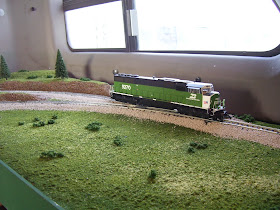I was in Nashville, TN just over a year ago. My hotel was near the former Nashville Union Station, now a (very nice) Wyndham Hotel.
Walking around the back, along the CSX main line, I came across the two forlorn VIA passenger cars pictured above. (Photo taken with my cell phone.) This isn't a place to find old Canadian passenger cars. How did they end up there?
Thanks to the Internet, I found out. The first car is former VIA 9479. Built by Pullman Standard in 1948 as NYC 10443, a 22 roomette sleeper named Thunder Bay, it was sold to CN in 1958 and was renamed CN 2067 Valparaiso.
In 1973 it was converted to a baggage-dormitory car with 14 roomettes and renumbered CN 9479. It was transferred to VIA in March 1978 and placed in storage in 1992. See a much better photo below, taken by Doug Wolfe and found on
Railroad Picture Archives.
The second car is VIA 2149 Clearwater River. It was built by Pullman Standard in 1949 as Erie 10&6 sleeper Benjamin Loder. It was sold to CN in 1958 and numbered 2149. In 1978 it was transferred to VIA and placed in storage in 1990.
The car is believed to be the sole survivor of the seven cars (Benjamin Loder, Charles Minot, Daniel Craig McCallum, Eleazar Lord, James Gore King, Marvin Kent and William Reynolds) built by Pullman Standard, to plan 4129A in lot 6797, for the Erie in 1949.
See another better photo, this one by John Owens, also from
Railroad Picture Archives.
The two cars, now numbered SLCX (St. Lawrence Cement) 2149 and 9479, belong to a development company in Nashville that uses the name “Gateway to Nashville, LLC.” Apparently, they were going to be fixed up for re-use, but that clearly hasn’t happened yet.
The tracks they are on are not connected to the nearby CSX line; behind them, and underneath the bridge (as seen in the second photo), there are other VIA passenger cars in various stages of reconstruction at Cummins Station. Anyone know anything about them?
(Thanks to Bryce Lee, former editor of Canada Calling, for the info on the cars.)


























